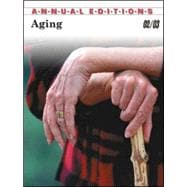| To the Reader | iv | ||||
| Topic Guide | 2 | (2) | |||
| Selected World Wide Web Sites | 4 | (2) | |||
| UNIT 1 The Phenomenon of Aging | |||||
|
6 | (2) | |||
|
8 | (1) | |||
|
|||||
|
|||||
|
|||||
|
9 | (6) | |||
|
|||||
|
|||||
|
|||||
|
|||||
|
15 | (7) | |||
|
|||||
|
|||||
|
22 | (5) | |||
|
|||||
|
|||||
|
|||||
|
27 | (2) | |||
|
|||||
|
|||||
|
|||||
|
29 | (5) | |||
|
|||||
|
|||||
|
|||||
|
|||||
| UNIT 2 The Quality of Later Life | |||||
|
32 | (2) | |||
|
34 | (3) | |||
|
|||||
|
|||||
|
|||||
|
37 | (5) | |||
|
|||||
|
|||||
|
|||||
|
42 | (2) | |||
|
|||||
|
|||||
|
|||||
|
44 | (4) | |||
|
|||||
|
|||||
|
|||||
|
|||||
|
48 | (5) | |||
|
|||||
|
|||||
|
|||||
|
53 | (3) | |||
|
|||||
|
|||||
|
|||||
|
|||||
|
56 | (1) | |||
|
|||||
|
|||||
|
|||||
|
57 | (6) | |||
|
|||||
|
|||||
|
|||||
| UNIT 3 Societal Attitudes Toward Old Age | |||||
|
60 | (3) | |||
|
63 | (3) | |||
|
|||||
|
|||||
|
|||||
|
|||||
|
66 | (6) | |||
|
|||||
|
|||||
|
|||||
|
|||||
|
|||||
|
72 | (3) | |||
|
|||||
|
|||||
|
75 | (5) | |||
|
|||||
|
|||||
|
|||||
|
|||||
|
|||||
|
|||||
|
80 | (6) | |||
|
|||||
|
|||||
|
|||||
|
|||||
|
|||||
| UNIT 4 Problems and Potentials of Aging | |||||
|
84 | (2) | |||
|
86 | (3) | |||
|
|||||
|
|||||
|
|||||
|
|||||
|
|||||
|
89 | (6) | |||
|
|||||
|
|||||
|
|||||
|
|||||
|
95 | (5) | |||
|
|||||
|
|||||
|
|||||
|
100 | (4) | |||
|
|||||
|
|||||
|
104 | (4) | |||
|
|||||
|
|||||
|
|||||
| UNIT 5 Retirement: American Dream or Dilemma? | |||||
|
106 | (2) | |||
|
108 | (7) | |||
|
|||||
|
|||||
|
|||||
|
115 | (2) | |||
|
|||||
|
|||||
|
|||||
|
|||||
|
117 | (1) | |||
|
|||||
|
|||||
|
|||||
|
118 | (2) | |||
|
|||||
|
|||||
|
|||||
|
|||||
|
|||||
|
120 | (4) | |||
|
|||||
|
|||||
|
|||||
|
124 | (15) | |||
|
|||||
|
|||||
|
|||||
| UNIT 6 The Experience of Dying | |||||
|
136 | (3) | |||
|
139 | (3) | |||
|
|||||
|
|||||
|
|||||
|
|||||
|
142 | (4) | |||
|
|||||
|
|||||
|
146 | (4) | |||
|
|||||
|
|||||
|
150 | (2) | |||
|
|||||
|
|||||
|
|||||
|
|||||
|
|||||
|
152 | (10) | |||
|
|||||
|
|||||
| UNIT 7 Living Environments in Later Life | |||||
|
160 | (2) | |||
|
162 | (2) | |||
|
|||||
|
|||||
|
|||||
|
|||||
|
164 | (12) | |||
|
|||||
|
|||||
|
|||||
|
|||||
|
|||||
|
|||||
|
|||||
|
176 | (2) | |||
|
|||||
|
|||||
|
|||||
|
178 | (3) | |||
|
|||||
|
|||||
|
|||||
|
|||||
|
181 | (3) | |||
|
|||||
|
|||||
|
184 | (6) | |||
|
|||||
|
|||||
|
|||||
| UNIT 8 Social Policies, Programs, and Services for Older Americans | |||||
|
188 | (2) | |||
|
190 | (5) | |||
|
|||||
|
|||||
|
|||||
|
|||||
|
195 | (3) | |||
|
|||||
|
|||||
|
|||||
|
|||||
|
|||||
|
|||||
|
198 | (2) | |||
|
|||||
|
|||||
|
|||||
|
|||||
|
|||||
|
200 | (3) | |||
|
|||||
|
|||||
|
|||||
|
|||||
|
|||||
|
|||||
|
203 | (2) | |||
|
|||||
|
|||||
|
|||||
|
|||||
|
205 | (4) | |||
|
|||||
|
|||||
|
|||||
|
|||||
|
|||||
| Index | 209 | (3) | |||
| Test Your Knowledge Form | 212 | (1) | |||
| Article Rating Form | 213 |








